2012 RENAULT SANDERO battery
[x] Cancel search: batteryPage 9 of 183
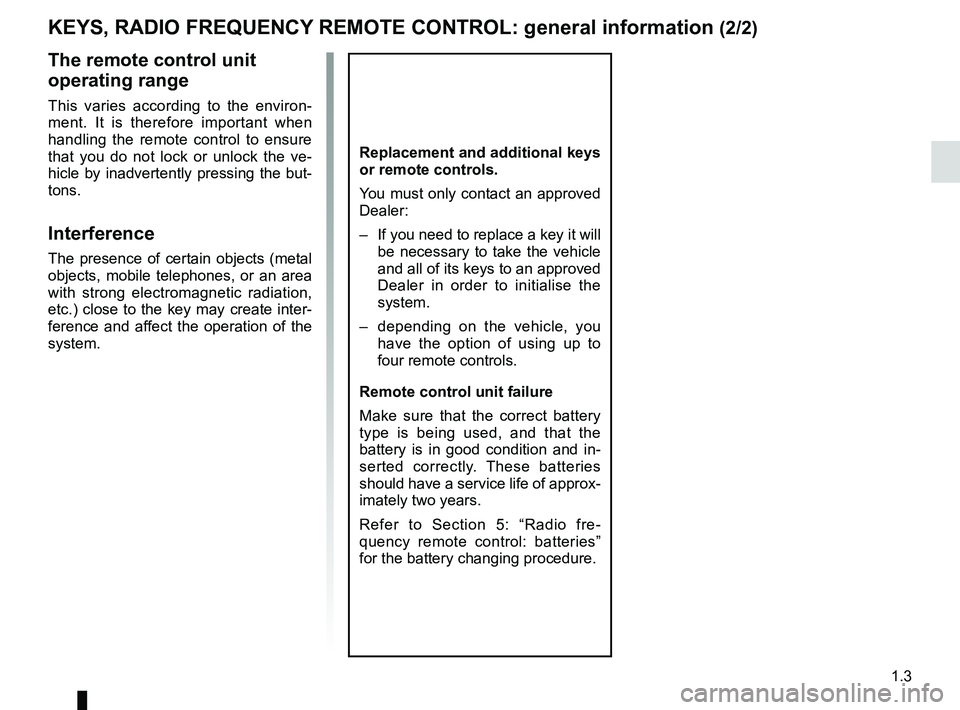
JauneNoirNoir texte
1.3
ENG_UD18185_9
Clés / télécommande à radiofréquence: généralité\
s (B90 - L90 - F90 - U90 - R90 - L90 Ph2 - F90 Ph2 - R90 Ph2 - Dacia)
ENG_NU_817-9_B90_Dacia_1
The remote control unit
operating range
This varies according to the environ -
ment. It is therefore important when
handling the remote control to ensure
that you do not lock or unlock the ve -
hicle by inadvertently pressing the but-
tons.
Interference
The presence of certain objects (metal
objects, mobile telephones, or an area
with strong electromagnetic radiation,
etc.) close to the key may create inter-
ference and affect the operation of the
system.
KEYS, RADIO FREQUENCY REMOTE CONTROL: general information (2/2)
Replacement and additional keys
or remote controls.
You must only contact an approved
Dealer:
– If you need to replace a key it will
be necessary to take the vehicle
and all of its keys to an approved
Dealer in order to initialise the
system.
– depending on the vehicle, you
have the option of using up to
four remote controls.
Remote control unit failure
Make sure that the correct battery
type is being used, and that the
battery is in good condition and in -
serted correctly. These batteries
should have a service life of approx -
imately two years.
Refer to Section 5: “Radio fre -
quency remote control: batteries”
for the battery changing procedure.
Page 10 of 183
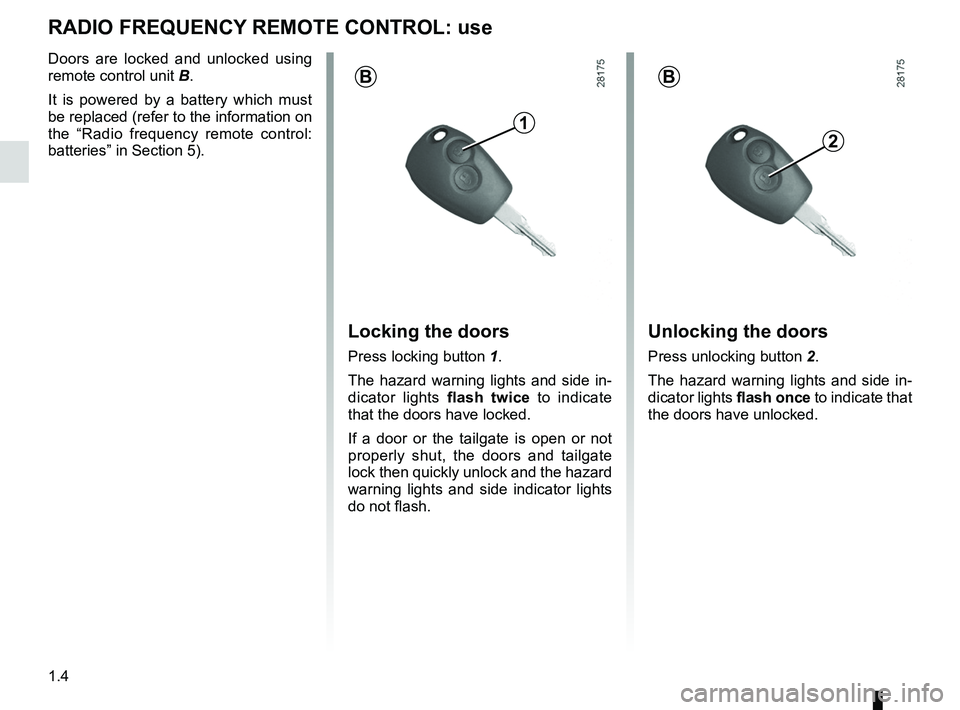
1.4
ENG_UD18223_4
Télécommande à radiofréquence : utilisation (B90 - L90 - F9\
0 - U90 - R90 - L90 Ph2 - F90 Ph2 - R90 Ph2 - H79 - Dacia)
ENG_NU_817-9_B90_Dacia_1
RADIO FREQUENCY REMOTE CONTROL: use
Doors are locked and unlocked using
remote control unit B.
It is powered by a battery which must
be replaced (refer to the information on
the “Radio frequency remote control:
batteries” in Section 5).
Locking the doors
Press locking button 1.
The hazard warning lights and side in-
dicator lights flash twice to indicate
that the doors have locked.
If a door or the tailgate is open or not
properly shut, the doors and tailgate
lock then quickly unlock and the hazard
warning lights and side indicator lights
do not flash.
Unlocking the doors
Press unlocking button 2.
The hazard warning lights and side in-
dicator lights flash once to indicate that
the doors have unlocked.
1
2
BB
Page 12 of 183

children ................................................. (up to the end of the DU)
doors ..................................................... (up to the end of the DU)
child safety ............................................ (up to the end of the DU)
opening the doors ................................. (up to the end of the DU)
closing the doors .................................. (up to the end of the DU)
locking the doors .................................. (up to the end of the DU)
1.6
ENG_UD20291_5
Ouverture et fermeture des portes (B90 - Dacia)
ENG_NU_817-9_B90_Dacia_1
Opening and closing the doors
OPENING AND CLOSING THE DOORS
Opening the doors manually
from the outside
With the doors unlocked (refer to the
information on “Locking/unlocking the
doors” in Section 1).
Front: Place your hand behind handle 1
and pull it towards you..
Rear (manual opening) : lift unlocking
button 2 from the inside and move the
door handle.
Opening the doors from the
inside
Front: pull handle 3.
Rear: from the inside, lift unlocking
button 2 and pull door handle 3.
Lights-on reminder buzzer
If you have left the lights on after switch-
ing off the ignition, a warning buzzer will
sound when a front door is opened (to
prevent the battery from discharging,
etc.).
1
2
As a safety precaution,
the doors should only be
opened or closed when the
vehicle is stationary.
3
Driver’s responsibility
when parking or stopping
the vehicle
Never leave an animal,
child or adult who is not self-suffi -
cient alone on your vehicle, even for
a short time.
They may pose a risk to themselves
or to others by starting the engine,
activating equipment such as the
electric windows or by locking the
doors.
Also, in hot and/or sunny weather,
please remember that the tempera-
ture inside the passenger compart-
ment increases very quickly.
RISK OF DEATH OR SERIOUS
INJURY.
Page 16 of 183
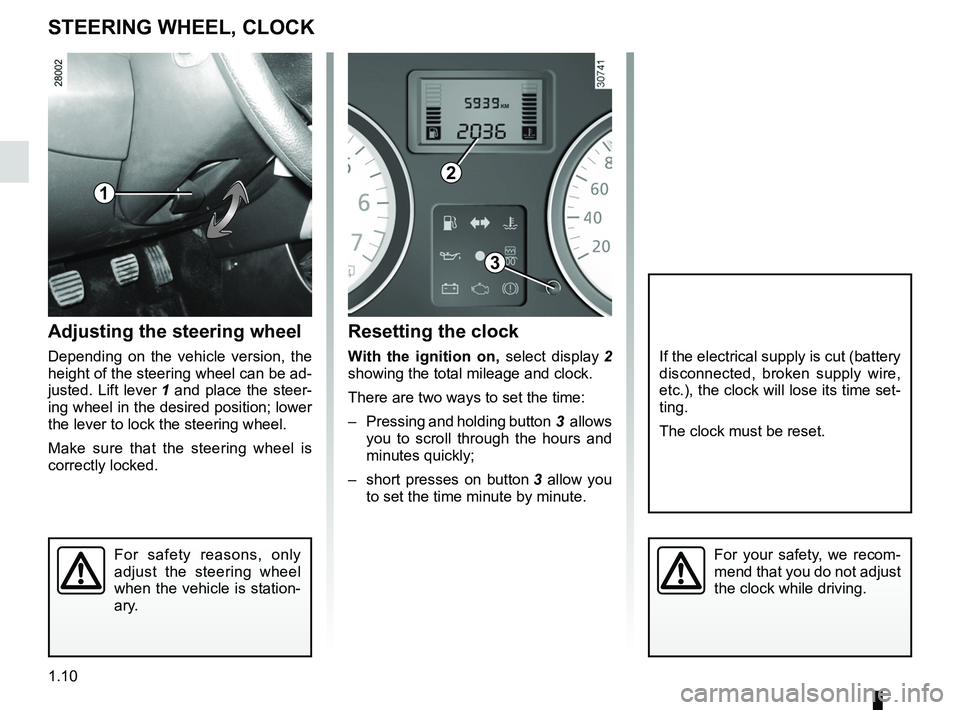
clock ..................................................... (up to the end of the DU)
clock ..................................................... (up to the end of the DU)
control instruments ................................................ (current page)
steering wheel adjustment ...................................... (up to the end of the DU)
1.10
ENG_UD20447_10
Volant de direction/Heure (B90 - L90 Ph2 - F90 Ph2 - R90 Ph2 - Dacia)
ENG_NU_817-9_B90_Dacia_1
Steering wheel, Clock
STEERING WHEEL, CLOCK
Adjusting the steering wheel
Depending on the vehicle version, the
height of the steering wheel can be ad-
justed. Lift lever 1 and place the steer-
ing wheel in the desired position; lower
the lever to lock the steering wheel.
Make sure that the steering wheel is
correctly locked.
For safety reasons, only
adjust the steering wheel
when the vehicle is station-
ary.
If the electrical supply is cut (battery
disconnected, broken supply wire,
etc.), the clock will lose its time set-
ting.
The clock must be reset.
Resetting the clock
With the ignition on, select display 2
showing the total mileage and clock.
There are two ways to set the time:
– Pressing and holding button 3 allows
you to scroll through the hours and
minutes quickly;
– short presses on button 3 allow you
to set the time minute by minute.
2
1
For your safety, we recom -
mend that you do not adjust
the clock while driving.
2
3
Page 47 of 183
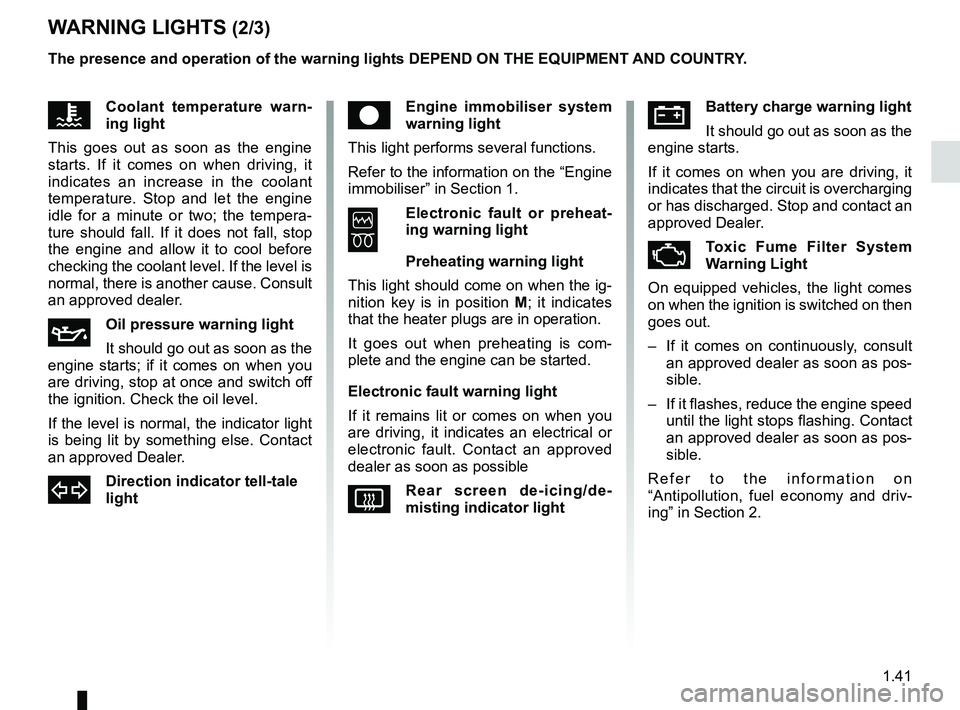
JauneNoirNoir texte
1.41
ENG_UD19003_9
Tableau de bord : témoins lumineux (B90 - L90 Ph2 - F90 Ph2 - R90 Ph2\
- Dacia)
ENG_NU_817-9_B90_Dacia_1
W ARNING LIGHTS (2/3)
êEngine immobiliser system
warning light
This light performs several functions.
Refer to the information on the “Engine
immobiliser” in Section 1.
6
Electronic fault or preheat -
ing warning light
Preheating warning light
This light should come on when the ig-
nition key is in position M; it indicates
that the heater plugs are in operation.
It goes out when preheating is com -
plete and the engine can be started.
Electronic fault warning light
If it remains lit or comes on when you
are driving, it indicates an electrical or
electronic fault. Contact an approved
dealer as soon as possible
VRear screen de-icing/de -
misting indicator light
ÚBattery charge warning light
It should go out as soon as the
engine starts.
If it comes on when you are driving, it
indicates that the circuit is overcharging
or has discharged. Stop and contact an
approved Dealer.
ÄToxic Fume Filter System
Warning Light
On equipped vehicles, the light comes
on when the ignition is switched on then
goes out.
– If it comes on continuously, consult
an approved dealer as soon as pos-
sible.
– If it flashes, reduce the engine speed
until the light stops flashing. Contact
an approved dealer as soon as pos-
sible.
R e f e r t o t h e i n f o r m a t i o n o n
“Antipollution, fuel economy and driv -
ing” in Section 2.
The presence and operation of the warning lights DEPEND ON THE EQUIPMENT\
AND COUNTRY.
ÔCoolant temperature warn
-
ing light
This goes out as soon as the engine
starts. If it comes on when driving, it
indicates an increase in the coolant
temperature. Stop and let the engine
idle for a minute or two; the tempera -
ture should fall. If it does not fall, stop
the engine and allow it to cool before
checking the coolant level. If the level is
normal, there is another cause. Consult
an approved dealer.
ÀOil pressure warning light
It should go out as soon as the
engine starts; if it comes on when you
are driving, stop at once and switch off
the ignition. Check the oil level.
If the level is normal, the indicator light
is being lit by something else. Contact
an approved Dealer.
dDirection indicator tell-tale
light
Page 55 of 183
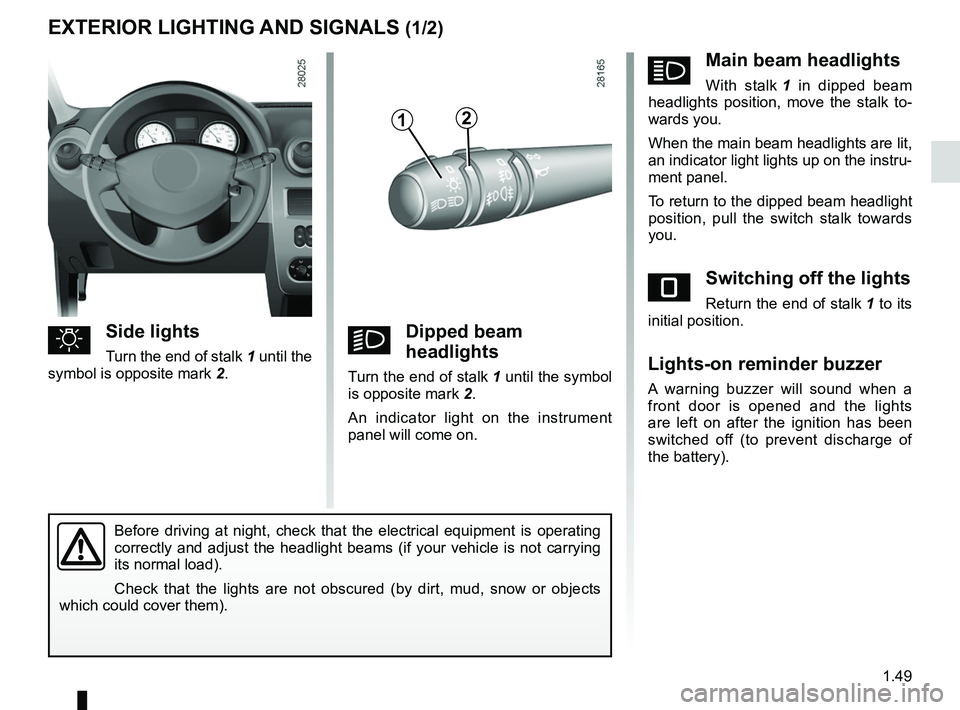
lighting:exterior ............................................ (up to the end of the DU)
lights: dipped beam headlights ................................... (current page)
lights: side lights ......................................................... (current page)
lights: main beam headlights ...................................... (current page)
lights ..................................................... (up to the end of the DU)
signals and lights .................................. (up to the end of the DU)
control instruments ............................... (up to the end of the DU)
1.49
ENG_UD18233_5
Éclairages et signalisations extérieures (B90 - L90 Ph2 - F90 Ph2\
- R90 Ph2 - Dacia)
ENG_NU_817-9_B90_Dacia_1
Exterior lighting and signals
EXTERIOR LIGHTING AND SIGNALS (1/2)
uSide lights
Turn the end of stalk 1 until the
symbol is opposite mark 2.kDipped beam
headlights
Turn the end of stalk 1 until the symbol
is opposite mark 2.
An indicator light on the instrument
panel will come on.
áMain beam headlights
With stalk 1 in dipped beam
headlights position, move the stalk to -
wards you.
When the main beam headlights are lit,
an indicator light lights up on the instru-
ment panel.
To return to the dipped beam headlight
position, pull the switch stalk towards
you.
eSwitching off the lights
Return the end of stalk 1 to its
initial position.
Lights-on reminder buzzer
A warning buzzer will sound when a
front door is opened and the lights
are left on after the ignition has been
switched off (to prevent discharge of
the battery).
Before driving at night, check that the electrical equipment is operating
correctly and adjust the headlight beams (if your vehicle is not carrying
its normal load).
Check that the lights are not obscured (by dirt, mud, snow or objects
which could cover them).
12
Page 69 of 183
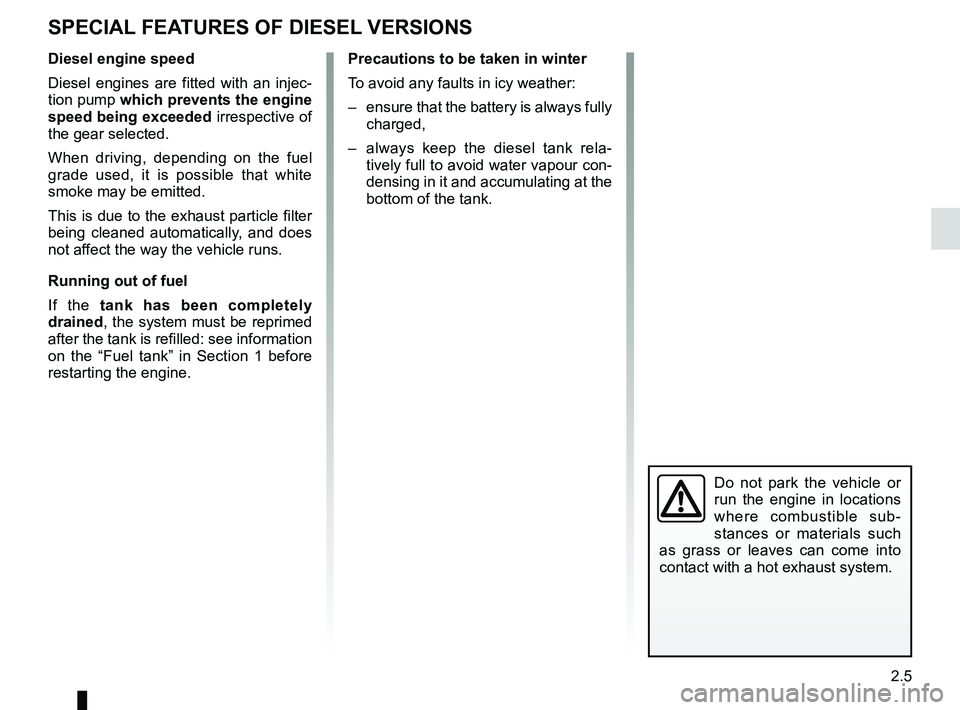
driving ................................................... (up to the end of the DU)
special features of diesel versions ........(up to the end of the DU)
filter particle filter .................................... (up to the end of the DU)
2.5
ENG_UD19740_7
Particularités des versions diesel (B90 - U90 - L90 Ph2 - F90 Ph2 - \
R90 Ph2 - Dacia)
ENG_NU_817-9_B90_Dacia_2
Special features of diesel versions
SPECIAL FEATURES OF DIESEL VERSIONS
Diesel engine speed
Diesel engines are fitted with an injec -
tion pump which prevents the engine
speed being exceeded irrespective of
the gear selected.
When driving, depending on the fuel
grade used, it is possible that white
smoke may be emitted.
This is due to the exhaust particle filter
being cleaned automatically, and does
not affect the way the vehicle runs.
Running out of fuel
If the tank has been completely
drained, the system must be reprimed
after the tank is refilled: see information
on the “Fuel tank” in Section 1 before
restarting the engine.Precautions to be taken in winter
To avoid any faults in icy weather:
– ensure that the battery is always fully
charged,
– always keep the diesel tank rela -
tively full to avoid water vapour con-
densing in it and accumulating at the
bottom of the tank.
Do not park the vehicle or
run the engine in locations
where combustible sub -
stances or materials such
as grass or leaves can come into
contact with a hot exhaust system.
Page 103 of 183
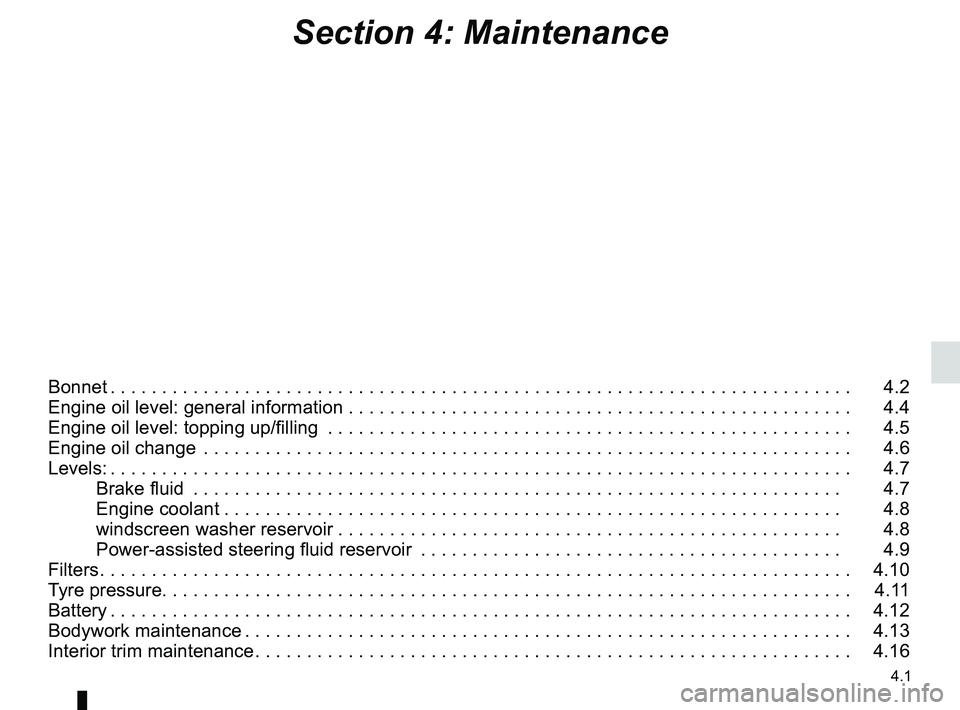
4.1
ENG_UD25174_11
Sommaire 4 (B90 - Dacia)
ENG_NU_817-9_B90_Dacia_4
Section 4: Maintenance
Bonnet . . . . . . . . . . . . . . . . . . . . . . . . . . . . . . . . . . . . . . . . . . . . . . . . . . . . . . . . . . . . . . . . . . . . . . . . 4.2
Engine oil level: general information . . . . . . . . . . . . . . . . . . . . . . . . . . . . . . . . . . . . . . . . . . . . . . . . . 4.4
Engine oil level: topping up/filling . . . . . . . . . . . . . . . . . . . . . . . . . . . . . . . . . . . . . . . . . . . . . . . . . . . 4.5
Engine oil change . . . . . . . . . . . . . . . . . . . . . . . . . . . . . . . . . . . . . . . . . . . . . . . . . . . . . . . . . . . . . . . 4.6
Levels: . . . . . . . . . . . . . . . . . . . . . . . . . . . . . . . . . . . . . . . . . . . . . . . . . . . . . . . . . . . . . . . . . . . . . . . . 4.7
Brake fluid . . . . . . . . . . . . . . . . . . . . . . . . . . . . . . . . . . . . . . . . . . . . . . . . . . . . . . . . . . . . . . . 4.7
Engine coolant . . . . . . . . . . . . . . . . . . . . . . . . . . . . . . . . . . . . . . . . . . . . . . . . . . . . . . . . . . . . 4.8
windscreen washer reservoir . . . . . . . . . . . . . . . . . . . . . . . . . . . . . . . . . . . . . . . . . . . . . . . . . 4.8
Power-assisted steering fluid reservoir . . . . . . . . . . . . . . . . . . . . . . . . . . . . . . . . . . . . . . . . . 4.9
Filters . . . . . . . . . . . . . . . . . . . . . . . . . . . . . . . . . . . . . . . . . . . . . . . . . . . . . . . . . . . . . . . . . . . . . . . . . 4.10
Tyre pressure. . . . . . . . . . . . . . . . . . . . . . . . . . . . . . . . . . . . \
. . . . . . . . . . . . . . . . . . . . . . . . . . . . . . . 4.11
Battery . . . . . . . . . . . . . . . . . . . . . . . . . . . . . . . . . . . . . . . . . . . . . . . . . . . . . . . . . . . . . . . . . . . . . . . . 4.12
Bodywork maintenance . . . . . . . . . . . . . . . . . . . . . . . . . . . . . . . . . . . . . . . . . . . . . . . . . . . . . . . . . . . 4.13
Interior trim maintenance . . . . . . . . . . . . . . . . . . . . . . . . . . . . . . . . . . . . . . . . . . . . . . . . . . . . . . . . . . 4.16